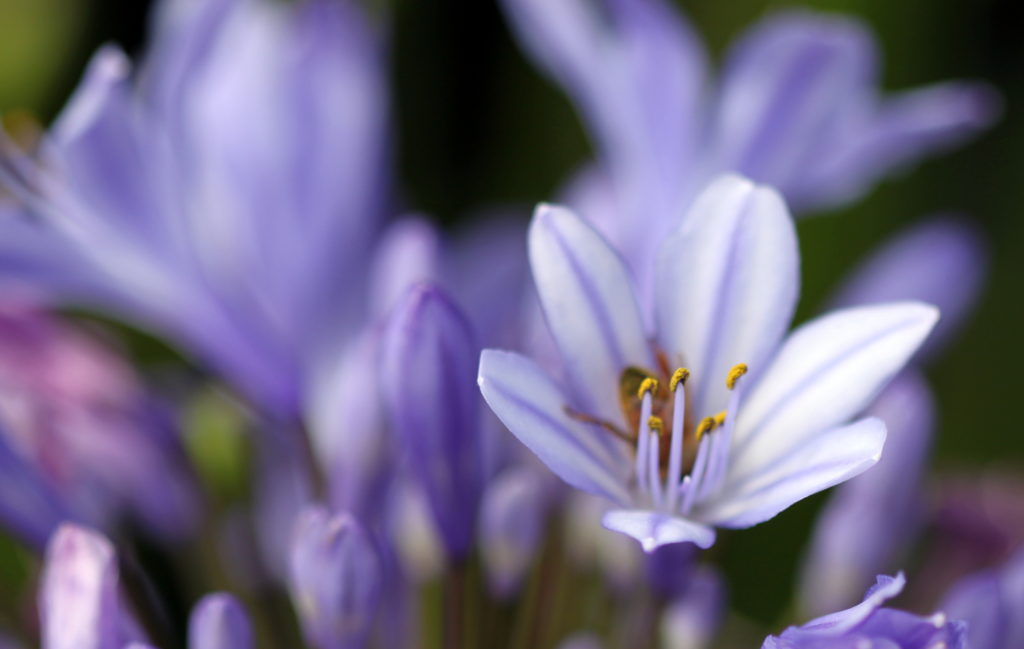Australia boasts around 24,000 diverse species of native plants, many of which can be sustainable, low-maintenance, and wonderful additions to your garden.
Growing native Australian plants doesn’t just make your outdoor space look great — it helps to create a safe and nourishing environment for Aussie wildlife to flourish too. Plus, it’s surprisingly easy to cultivate these special indigenous flowering plants, shrubs, climbers, and orchids at home.
Find out how to bring a little of our country’s natural beauty into your own backyard with our Australian native plants guide.
What Are Agapanthus Plants?
Originating from southern Africa and also known as the African lily, agapanthus plants are part of the onion family.
With their abundant green leaves and eye-catching blue or white flowers balanced on tall stems, the agapanthus makes a welcome addition to any garden.
Agapanthus flowers throughout spring and summer, and occasionally during mild autumns and winters. Resistant to many diseases and tolerant of extreme weather conditions, they make an easy-care and attractive garden plant.
What Are the Different Types and Colours of Agapanthus Plant?

While the plant is traditionally associated with its blue flowers, agapanthus colours can range from delicate pastels through to vibrant indigos and purples, as well as white varieties.
The Bingo Blue is a classic agapanthus shade. Its bright blue flowers will love the sun, but the plant will also thrive in semi-shade and is resistant to drought and frost.
For a striking agapanthus plant, the Sugar Plum offers vibrant purple flowers in large quantities in the spring and summer and intermittently throughout the year, providing stunning displays.
White varieties of agapanthus can be mixed with blue plants for a contrasting look. Cloudy Days is predominantly white with hints of blue on its large flowers, working well in borders and with other agapanthus varieties.
What Are the Pros of Growing Agapanthus Plants?
There are many reasons for growing agapanthus:
- Agapanthus plants are hardy and will flourish in most types of soil.
- They have good resistance to disease and extreme weather.
- Agapanthus plants are low-maintenance and great for amateur gardeners.
- They are the perfect size for your borders without dominating other plants.
- Agapanthus can be a focal point or provide a burst of colour.
- They are also a practical choice to provide weed cover and prevent soil erosion on banks.
What Are the Cons of Growing Agapanthus Plants?
It’s hard to say a bad word about the agapanthus, but look out for the following issues:
- Agapanthus plants can get scalded in scorching hot weather. If this happens, move your plants to a shady area of the garden.
- The lily borer caterpillar can decimate agapanthus plants. You can remove them by hand, or you can cut out badly affected leaves.
- Because agapanthus plants spread quickly, they are regarded as an invasive weed in parts of New South Wales and Victoria. Your local council can provide guidance on growing agapanthus, which may include dead-heading flowers before seed dispersal.
- Agapanthus leaves, sap, and rhizomes (plant roots that grow horizontally) are poisonous if ingested. Ensure that children and pets don’t come into contact with these plants unsupervised.
Planting Agapanthus

Plant your agapanthus in spring, but be aware that it may take up to three years for the plants to establish themselves.
- First, select a suitable place for your agapanthus plants. They favour full sun to partly shaded areas but are not too fussy about the soil.
- Prepare the ground by digging in some soil improver or fertiliser.
- Dig a hole which measures approximately double the width and the same depth as your agapanthus’ root ball.
- Agapanthus plants should be placed between 30 and 60 cm apart, depending on the size of the variety.
- Gently place your plant in the hole and fill in with soil. Leave a raised ridge of soil around the border of your plant’s root area. This will help your plant take up water in the right place.
- Water copiously after planting and ensure that your agapanthus plant is kept moist for the following few weeks.
Agapanthus Aftercare
While the agapanthus is a low-maintenance plant, you will need to follow a few tips on agapanthus care to get the most out of your blooms.
- Mulch your agapanthus plants in autumn and feed twice during the growing season from early spring onwards.
- Water your agapanthus plants regularly.
- After your agapanthus has flowered, remove the old flowers to stimulate fresh growth and stop over-production of seeds.
- Agapanthus pruning is also essential to encourage healthy growth. You can do this after the flowering season, cutting back the stems to around 10 cm above ground level for deciduous varieties, which include Agapanthus Melbourne, Agapanthus Galaxy White, and Agapanthus Little Galaxy. Meanwhile, evergreen agapanthus plants (Agapanthus Black Pantha, Agapanthus Silver Baby, and Agapanthus Tornado, for example) only require a light trim to remove dead foliage.
- Dividing agapanthus should be carried out approximately every four years for evergreen varieties and every six to eight years for deciduous plants to prevent overcrowding. You can do this in spring or autumn, once the plants have finished flowering.
Months of Spectacular Blooms
Growing agapanthus plants is a pleasure, with the reward of spectacular blooms for up to six months a year.
Their low-maintenance and hardy nature makes them perfect for the Australian climate and will give you maximum returns for minimum hassle.
If you would like more advice on what native Australian plants would suit your garden, send us an enquiry, email daniel@mulchesandmore.com.au or call 0407 084 734!
